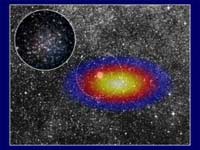Gamma-ray emission from Terzan 5 detected
29 Jun 2011
The H.E.S.S. telescope system in Namibia discovered a new source of very-high-energy gamma-rays from the direction of the globular cluster Terzan 5. Being very likely located in the outer parts of Terzan 5 this source is the first example for of gamma-ray emission from a globular cluster. The off-centre position of the source and the specific origin of the gamma-rays pose a puzzle for scientists.
 |
| The globular cluster Terzan 5 (centre) in visible light and the gamma-ray source HESS J1747 – 248. The gamma-ray intensity is displayed in false colours from blue (low) to white (high). The smaller circle (solid) comprises half of the mass of Terzan 5. A zoom on this central region in infrared light is depicted in the upper right inset. The larger circle (dashed) shows to what extension stars are gravitationally bound to the cluster. © ESO/Digitized Sky Survey 2 and ESO/F. Ferraro (IR) |
The globular cluster Terzan 5 situated in the Sagittarius constellation is a remarkable object in several aspects. Obscured behind galactic dust clouds the faint cluster was discovered in 1968 by Agop Terzan on photographic plates of the Haute-Provence Observatory in France. About 150 known globular clusters, concentrated spherical collection of very old stars, orbit the centre of our galaxy in form of a spherical swarm as part of the galactic halo.
Terzan 5 is located in the inner parts of our galaxy closely above the galactic plain in about 20,000 light-years distance to the earth. It has the highest density of stars of all globular clusters and contains the largest number of millisecond pulsars. The latter are rapidly rotating neutron stars which are thought to be part of close binary systems.
Terzan 5 gained particular attention in 2009 when it turned out that is has two star populations of different age (12 and 6 billion years, respectively). Due to these unique properties Terzan 5 is assumed to be the remnant of a dwarf galaxy which has been captured by our galaxy.
Researchers of the Max Planck Institute for Nuclear Physics in Heidelberg and 33 other institutions within the H.E.S.S. collaboration report the discovery of a new source (HESS J1747 – 248) of very-high-energy gamma-rays from the direction of Terzan 5. The location in the close vicinity to the cluster suggests that the source is a so far unknown part of Terzan 5.
The probability of a chance coincidence with an unrelated gamma emission (derived from the abundance of known sources) is less than 1/10,000.













.jpg)






.jpg)









